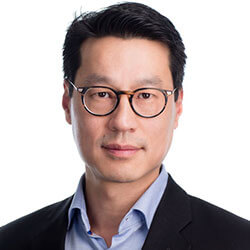Healthcare Spaces are Civic Spaces.
We believe that healthcare environments are important civic spaces that represent and embody the best aspirations of our communities.
Our buildings for Healthcare are dynamic, welcoming spaces that engage their context and contribute actively to the life of their neighborhood and city.
We partner with healthcare providers to create human-centered environments that enhance the way care is delivered and experienced. Our buildings are designed to support technological innovation, safety, and quality for patients, their families, caregivers, and staff.
Our design process is built around stakeholders re-thinking identity, process, and experience, and each initiative is an opportunity to imagine and implement new and better models of care. We create strategies for sustainability and resilience, focusing on the reduction of energy costs and carbon, and design for community, access, and equity.
We offer our Healthcare clients a full range of services
-
Architecture
-
Interior Design
-
Renovation
-
Historic Preservation
-
Strategic Planning
-
Master Planning
-
Programming
-
Land-use Planning and Entitlements
-
Resiliency Planning
-
Post-occupancy Evaluation
-
Facility Assesment
-
Campus Decarbonization
We offer our Healthcare clients a full range of services
-
Architecture
-
Interior Design
-
Renovation
-
Historic Preservation
-
Strategic Planning
-
Master Planning
-
Programming
-
Land-use Planning and Entitlements
-
Resiliency Planning
-
Post-occupancy Evaluation
-
Rapid Prototyping
Ennead’s Healthcare Center Leadership
Ennead’s Centers of Excellence were established to codify the firm’s experience in specific typologies to optimize and share expertise across the office. Each Center is led by senior Ennead staff who bring deep typological knowledge and and are recognized leaders in their respective markets. David Tepper and Melissa Sarko Alead teams that collaborate with healthcare systems and institutions to develop high-performance solutions resulting in transformative environments for patients, caregivers and clinicians alike.
Read David Tepper’s article on Pandemic-Ready Hospitals here.
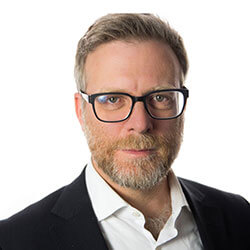
David Tepper
Principal
Healthcare Practice Leader
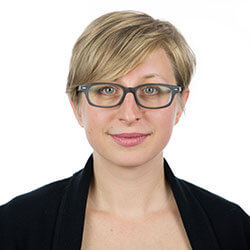
Melissa Sarko
Principal
Healthcare Practice Leader
“Healthcare is an area where design really matters and where traditionally there hasn’t been enough thoughtful design. Good design can have a tremendous impact on people’s lives in a healthcare setting. We really listen to the people who spend time in these buildings: patients and families, but also staff, nurses and physicians.”
David Tepper AIA, Principal
David Tepper is a Principal at Ennead Architects and leads the firm’s healthcare practice. David focuses on strategic planning, campus design, infrastructure and implementation for complex healthcare environments, working with stakeholders to define priorities and build consensus. He has a special expertise in resilience for essential facilities and works with institutions to plan for continued climate change, retrofit existing buildings, and establish standards for mission-critical facilities. David received a Master of Architecture degree from Harvard University in 1995 and a Bachelor of Arts from Columbia University in 1991. He is a member of the American Institute of Architects and the Society for Campus and University Planning.
Healthcare Experience
The David H. Koch Center for Cancer Care at Memorial Sloan Kettering Cancer Center, New York, NY
Cornell University, Weill Cornell Medicine, Weill Greenberg Center,
NYU Langone Health, Helen L. and Martin S. Kimmel Pavilion, New York, NY
New York University Langone Medical Center, Cogeneration Building, New York, NY
NYU Langone Health, Skirball Institute of Biomolecular Medicine, New York, NY
New York Academy of Medicine Expansion, New York, NY (unbuilt)
To see David Tepper’s full bio click here.
Melissa Sarko is a Principal at Ennead Architects and has played an integral role on a broad variety of healthcare projects. Her strong interest in project programming and planning is a critical component to the success of each of her projects. An expert in technical and regulatory requirements, Melissa has extraordinary talents motivating project teams and has experience managing large projects for complex institutional and government clients.
Healthcare Experience
Center East Life Sciences Hub, New York, NY
David H. Koch Center for Cancer Care at Memorial Sloan Kettering Cancer Center, New York, NY
Cornell University, Weill Cornell Medicine, New Laboratory Building (unbuilt), New York, NY
To see Melissa Sarko’s full bio click here.
In his 27-year tenure at Ennead, Thomas Wong has provided insightful design leadership on a broad range of building and program typologies, from museums to ambulatory care centers and inpatient hospitals. The projects he has designed span multiple geographic regions, from Asia and the Middle East to cities across the United States. The diversity of typologies and contexts in which he designs speak to the range of his design approach: Thomas treats each design problem as a unique set of opportunities and issues that lead to a distinct, specific, and authentic solution. His projects have received global recognition and multiple design awards.
Healthcare Experience
Inova Health, Eastern Region Projects
NYU Winthrop Hospital, Inpatient Replacement Hospital
NYU Winthrop Hospital, Strategic Master Plan
National University Health System, Center for Oral Health and Utility Plant
Weill Cornell Medicine, Weill Greenberg Center
Weill Cornell Medicine, Belfer Research Building
1101 Chestnut Ambulatory Care Center
Northwell Health, Lenox Hill Hospital Redevelopment
Projects at NYU Langone Health
NYU Langone Health, Alumni Hall
Helen L. and Martin S. Kimmel Pavilion
Grossman School of Medicine
New Energy Building and Central Utility Plant (Cogeneration Building)
Tisch Hospital Elevator Tower and Lobby
Manhattan Campus Master Plan
School of Medicine
Skirball Institute of Biomolecular Medicine & Residence Tower
Tisch Hospital Renovations, Cafeteria
NYU Langone Hospital—Brooklyn, New Ambulatory Surgery Center and Family Health Center Expansion
To see Thomas Wong’s full bio click here.
Ennead’s Approach to Healthcare
Buildings that are positive for all users
By balancing the needs of care teams with those of patients and visitors, we create spaces that empower patients, engender meaningful connections among users and improve the quality of care.
Design has the power to enhance the social, emotional and mental wellbeing of a healthcare community.
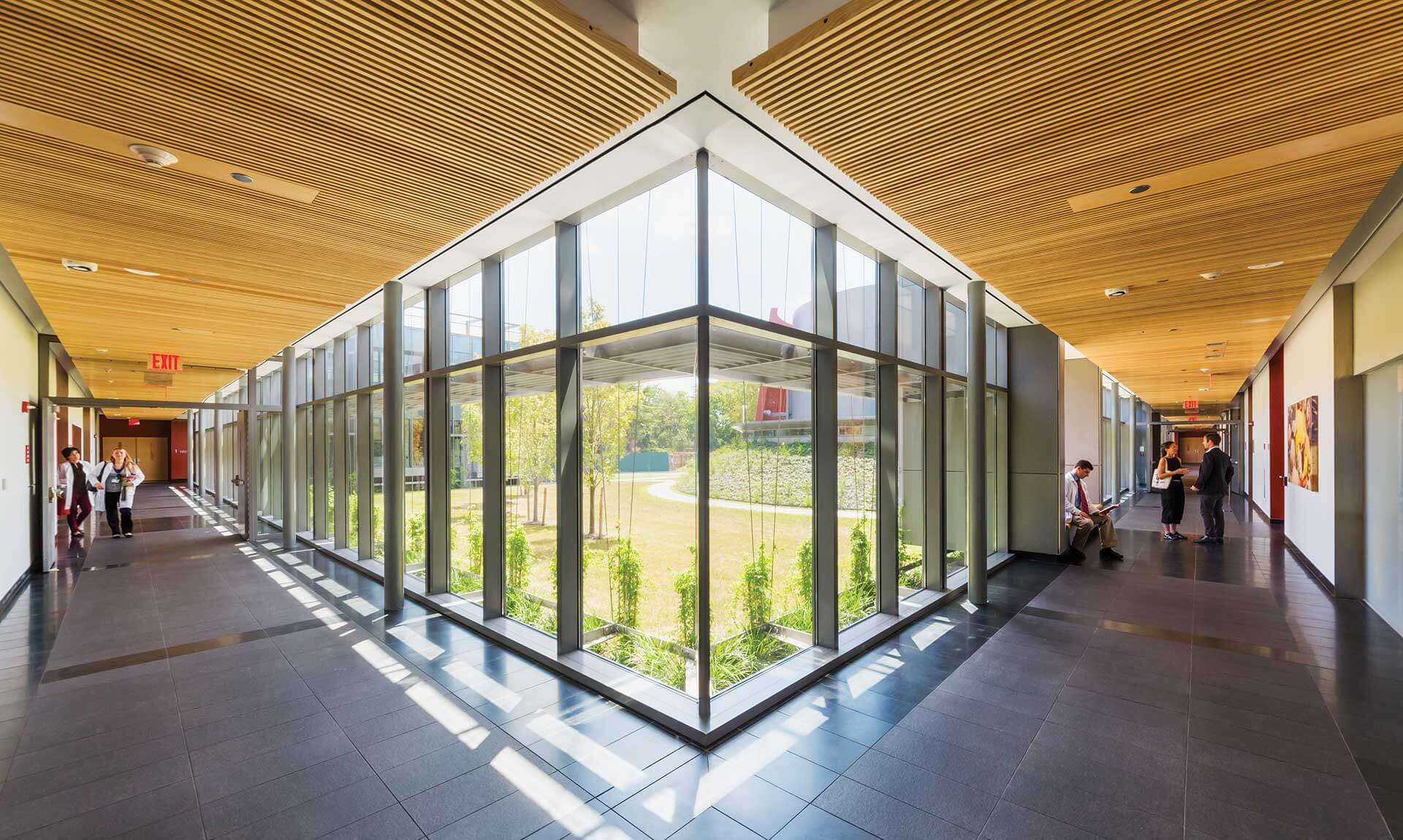
The patient experience is at the core of our approach. Competition to meet rising consumer expectations for experience, convenience and amenities are driving new standards for facility design. As the paradigm of where care is delivered shifts, beginning at home and continuing in clinics, hospitals, wellness centers and virtual communities, our focus is on establishing key touchpoints in the patient journey from arrival to discharge. Our goal is to provide an uncomplicated, calming progression that reduces stress and anxiety and leads to improved care outcomes.
Thoughtful design gives patients choices as to how they engage with their surroundings and care providers. Within clinical settings, clear wayfinding can instill a sense of security, enabling patients to effectively navigate their own courses of care. Establishing different spaces for varied levels of activity can meet users’ wide-ranging clinical, social and reflective needs. Integrating digital systems at multiple scales can further increase patient engagement and satisfaction.
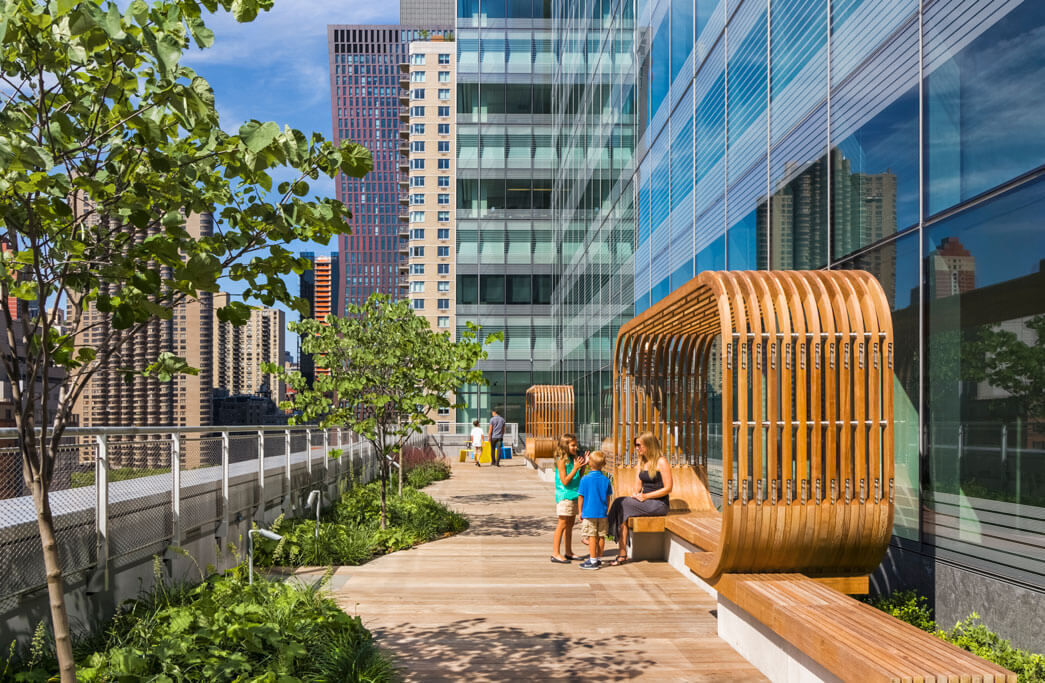

At NYU Langone Health, Helen L. and Martin S. Kimmel Pavilion corridors ending in light and views help to orient people on the bed floor. Team space off the corridor allows for impromptu meetings and quick communication between clinicians. Restorative environments, such as outdoor gardens, offer experiences that promote recovery through engagement with nature.
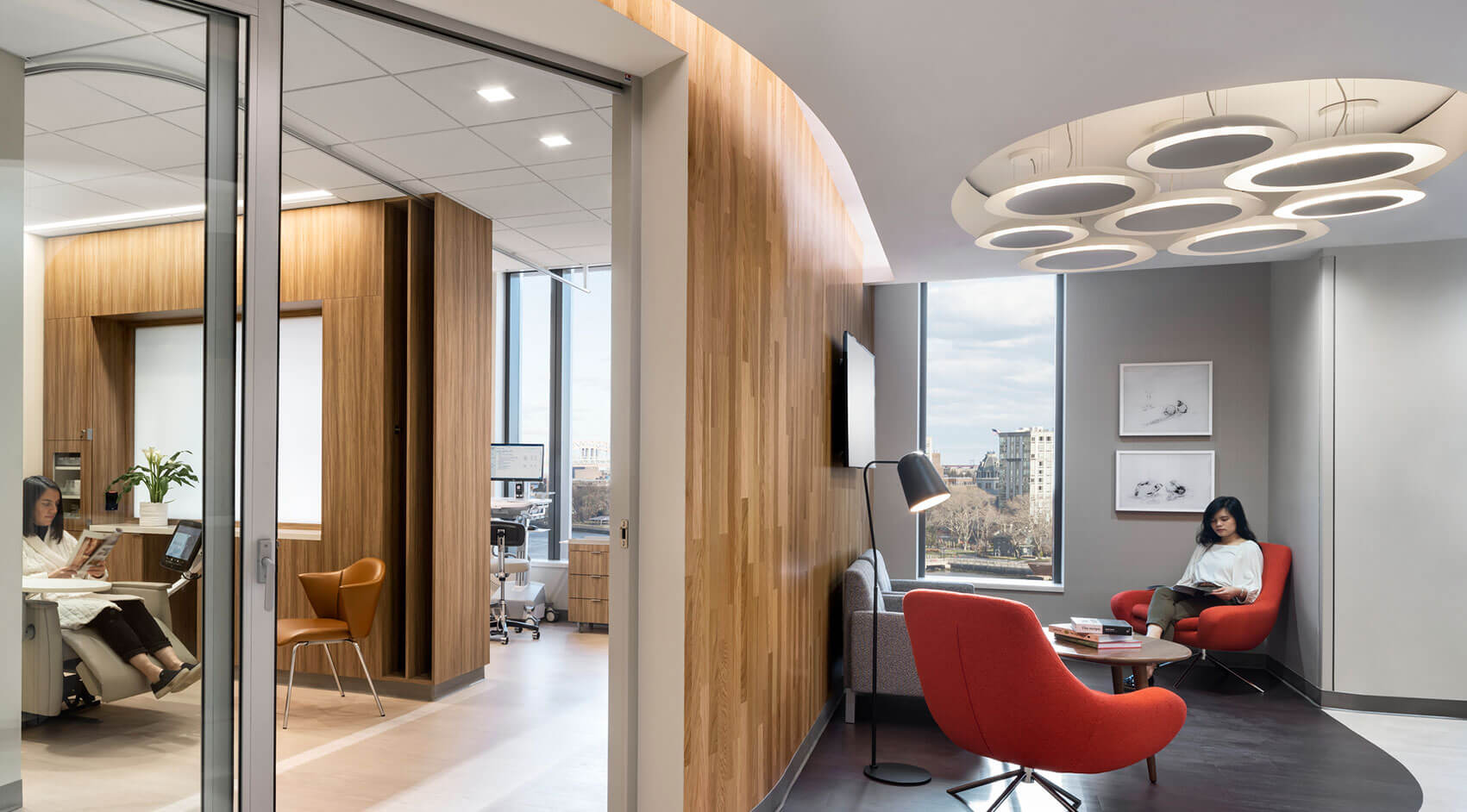
At The David H. Koch Center for Cancer Care at Memorial Sloan Kettering Cancer Center, the concept of “neighborhoods” transforms the patient waiting experience, with spaces established for a range of reflective and social needs.
As our healthcare clients grow and expand their regional networks, each building project is an opportunity to reconsider how and where care is delivered. We assess aging infrastructure across systems, consolidate and rationalize services and settings, and align real estate assets with strategic planning.

Our goal is to provide the right programs in the right settings, planning for buildings that provide patient-centric care while maximizing operational efficiency.
Increasingly sophisticated procedures can be done in outpatient settings. Primary and preventative care is shifting dramatically to commercial/retail and telemedicine settings. Inpatient bed need is decreasing, but patients who remain are sicker. Digital tools can connect care teams to resources outside of the hospital building, allowing access to diverse resources from across the system. Space on dense hospital campuses and in expensive facilities must be prioritized for highest and best use.
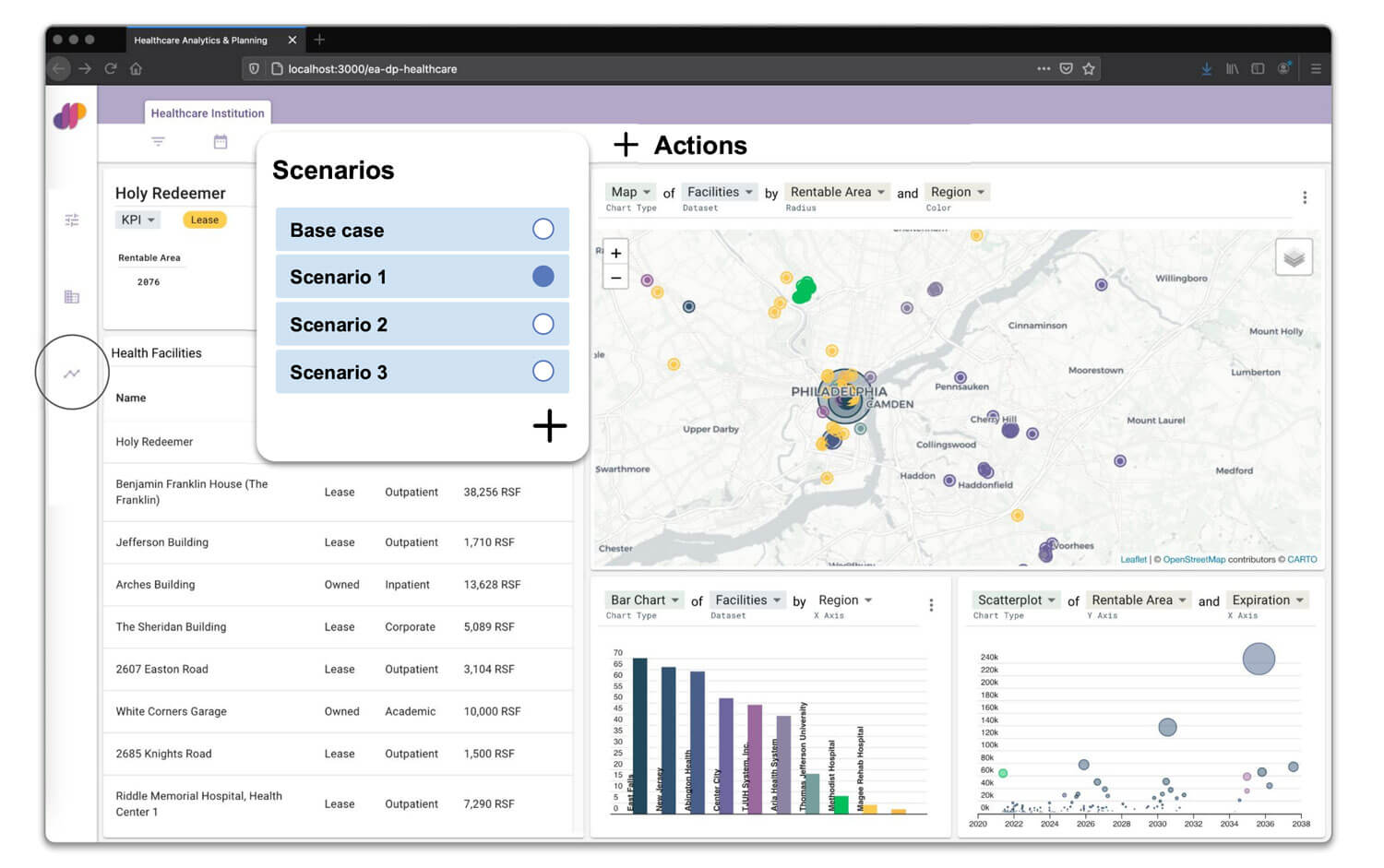
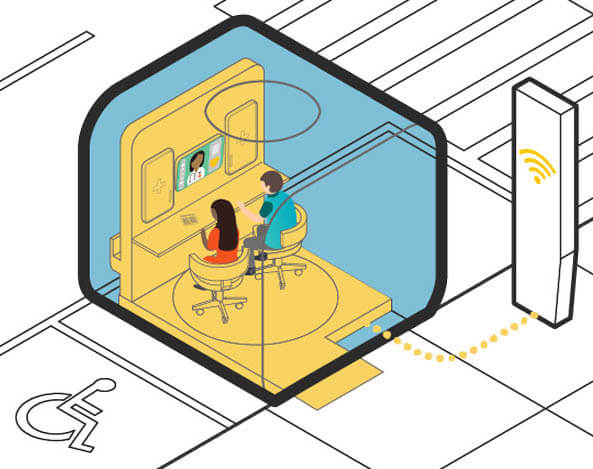
Take Care is a proposal for a new type of healthcare setting: a prefabricated telehealth pod, promoting access to high-quality and convenient primary care
We create customized digital tools to visualize large data sets essential to health systems planning. This sort of dynamic planning allows us to respond flexibly to the needs of each client to enhance facilities decision-making.
Buildings that are Resilient
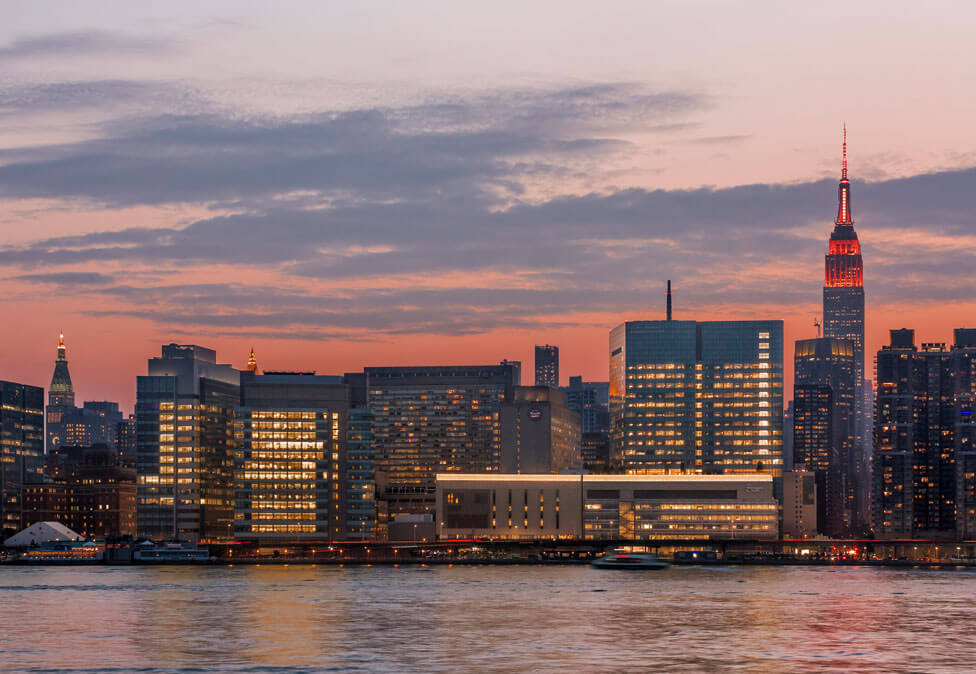
We create high-performance, mission-critical facilities that respond to current challenges and anticipate future ones.
We design healthcare facilities for maximum resiliency in the face of continually evolving systems and physical environments. Flexible programs, operations, and infrastructure allow providers to respond nimbly to both opportunities and threats.
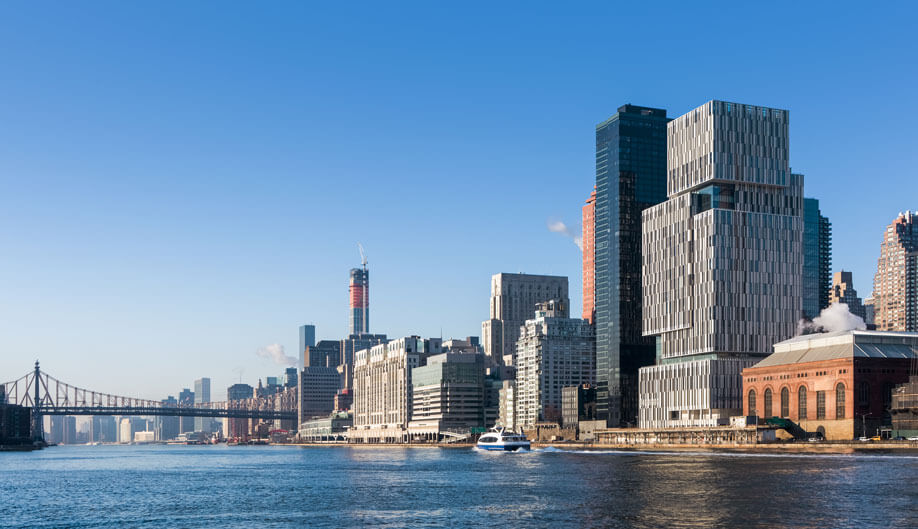
External challenges to providers can be regulatory in nature, like the expansion of site neutrality, or market-driven, such as the closure of a nearby competitor. Challenges may also come from acute environmental threats due to climate change and related extreme weather, including the increasing risk of hurricane-strength storms, flooding, high speed winds, and the subsequent loss of utility power. Facilities must be planned and constructed to respond to these potential hazards. Our strategies for sustainability and resilience focus on business continuity, reduction of energy costs and carbon, and design for community, access, and equity.
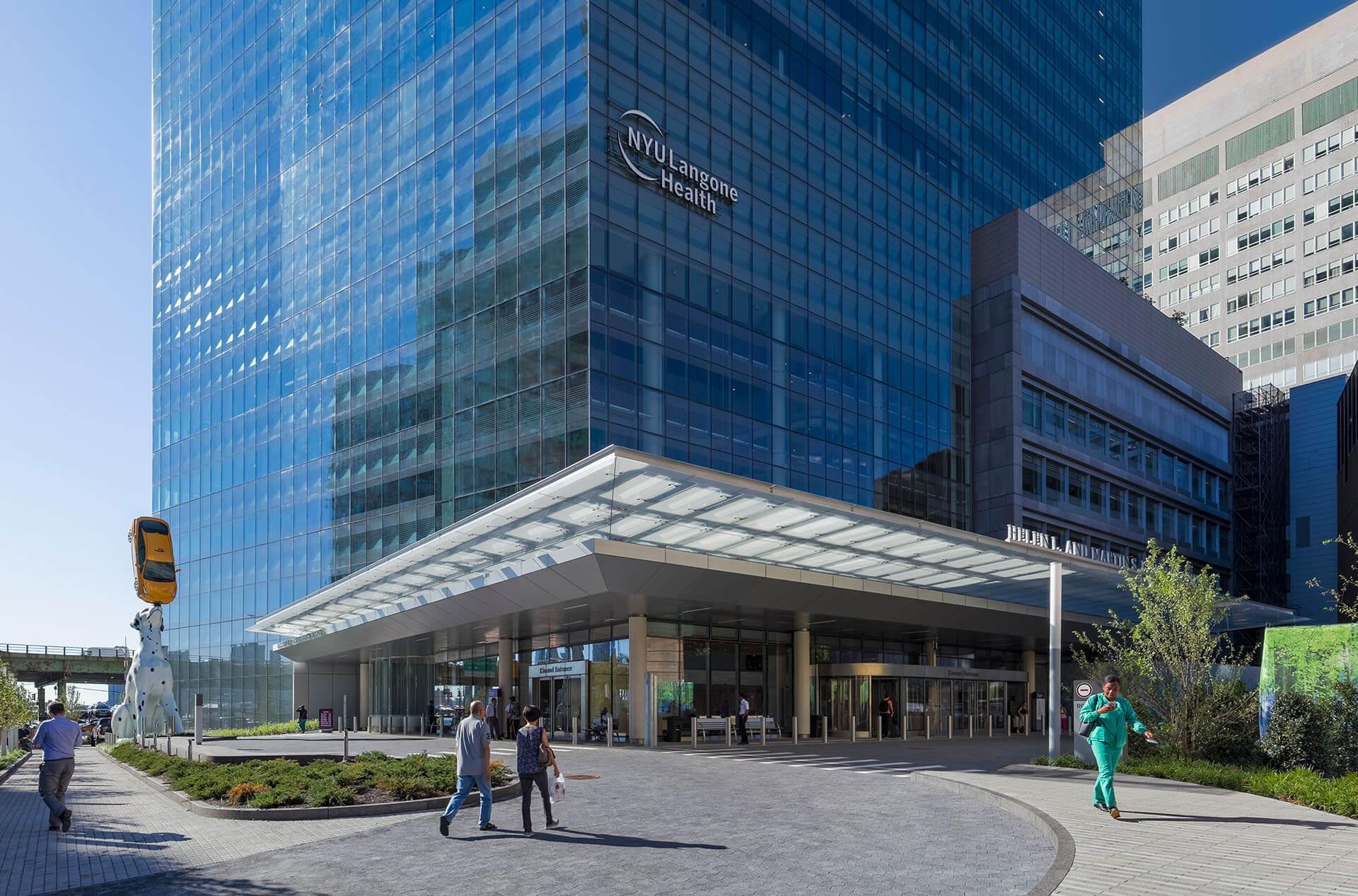
The design of the Kimmel Pavilion for NYU Langone Health in New York prioritized emergency preparedness and infection control. As a result, the flagship 400-bed inpatient tower was pandemic-ready when it open in 2018. As the COVID-19 pandemic peaked in NYC in 2020, complete acuity-adaptability allowed flexibility to become ICU care with negative pressure, and all patient units were converted to 100% outside air with a flip of a switch.
Buildings that Respond to Community Needs
By synthesizing input from healthcare professionals and community stakeholders we ensure that the design serves the diverse needs of its users and furthers institutional mission at every scale.
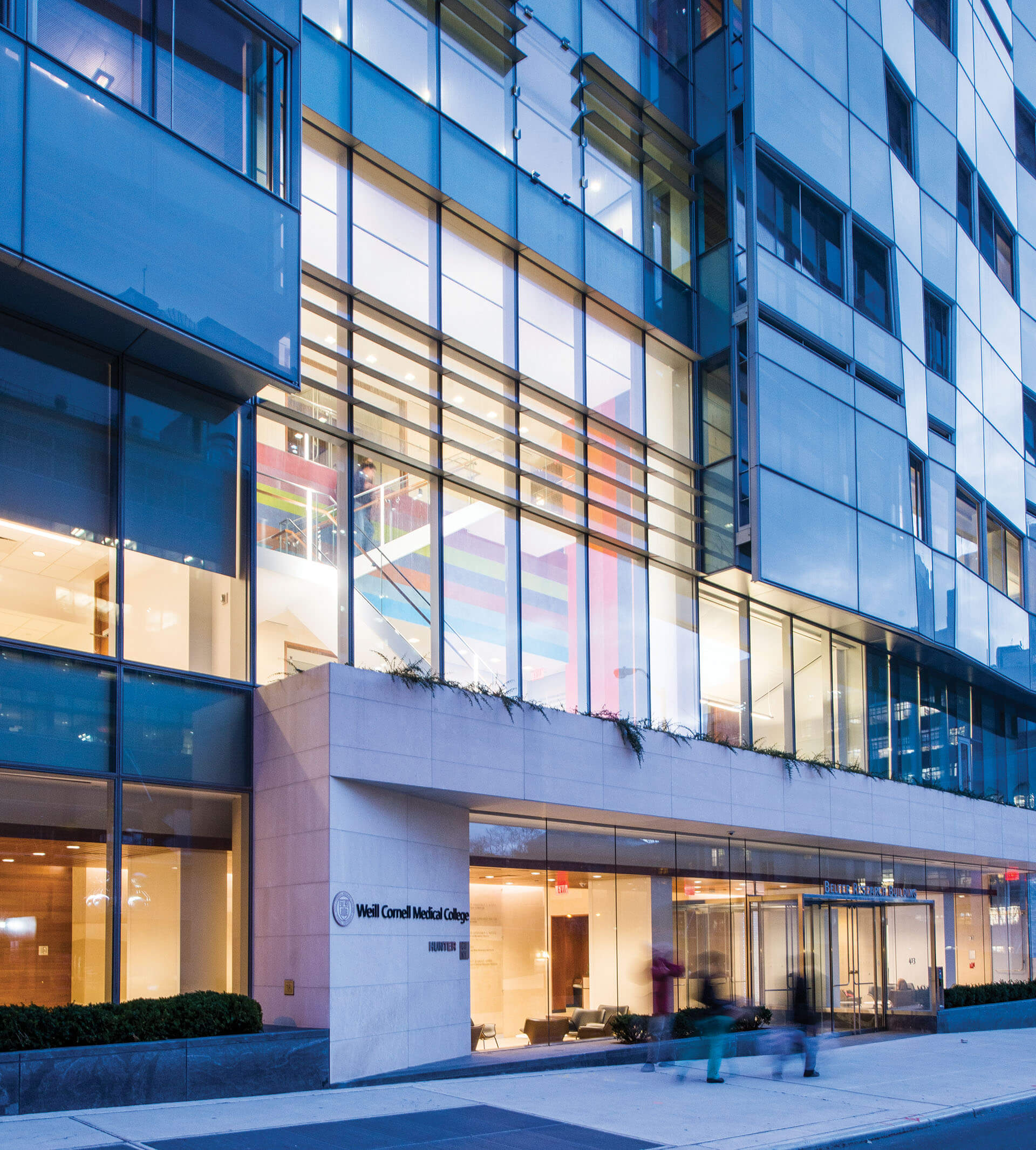
Our process is informed by rigorous research and community interaction to determine how architecture can facilitate public health and access to care.
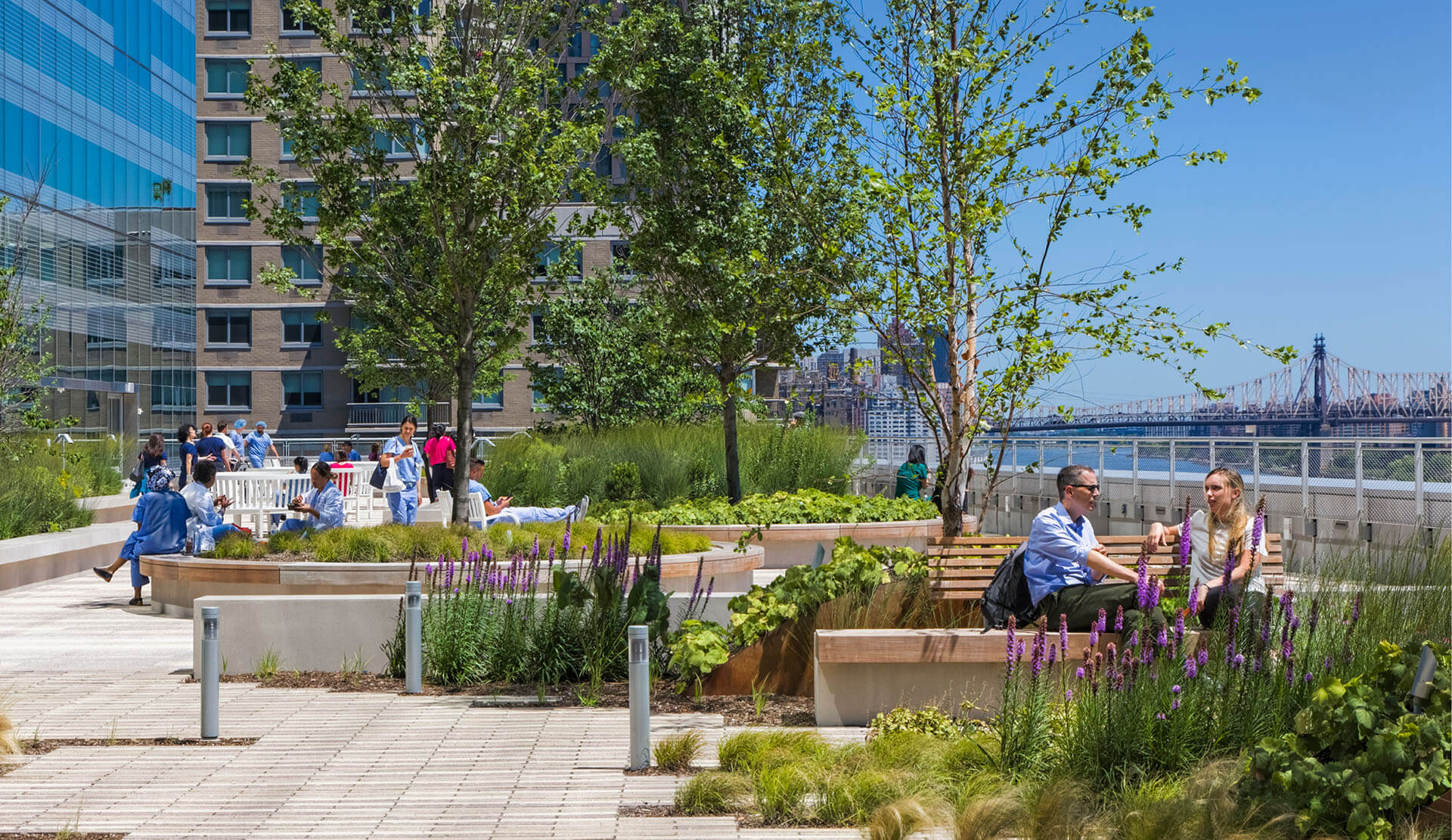
Our design process is human-centered. Each building reflects the values and aspirations of the community it serves and is rooted in cultural and historical context. We create buildings that not only reflect institutional identity but also provide for unique programs and amenities, as determined by our engagement process. These have included food distribution, cultural arts, education, holistic wellness and fitness, in addition to patient care spaces.
Master Planning
Our master plans align health system strategies with real estate assets to provide the right care in the right facility and setting. We untangle dense medical centers that have grown opportunistically to unlock development opportunities. Our goal is to create a framework that informs real estate decisions on an ongoing basis, allowing institutions to better assess sites small and large.
Our medical campus planning practice draws from our integrated strategies for sustainability and resilience. By establishing efficiencies through campus planning and integration, we create high-performance, mission-critical facilities.
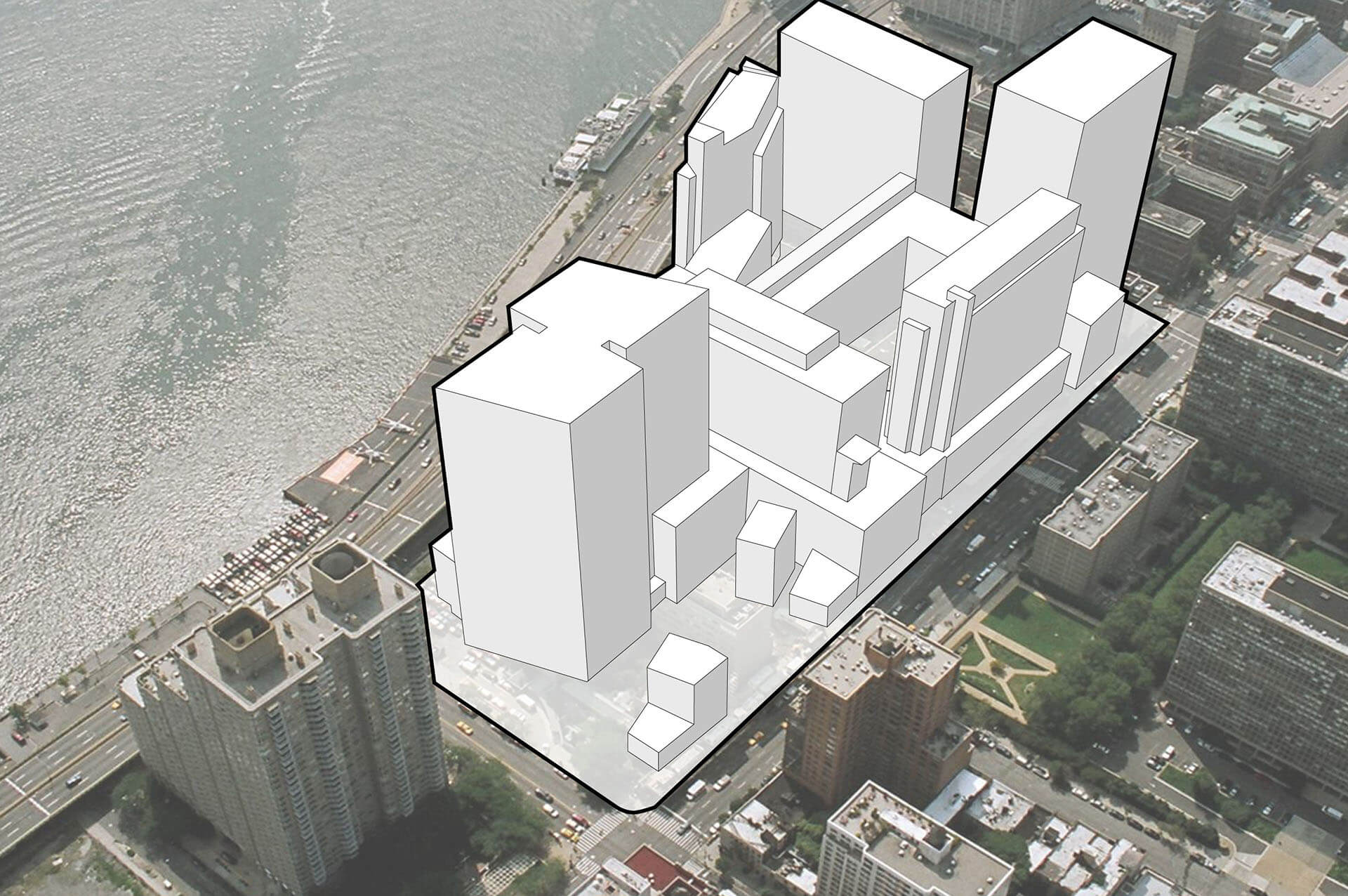
Selected Projects
Inova Eastern Region Planning, Programming, and Concept Design
Inova Central Region Planning, Programming, and Concept Design
NYU Langone Health Brooklyn Master Plan
NYU Langone Health Long Island Campus Transformation
Northwell Health, Zucker Hillside Hospital
NYU Langone Health, Master Plan and Campus Transformation
Weill Cornell Medicine Master Plan
Scroll over the NYU Langone Health Master Plan to explore Ennead’s work there.
Inpatient Care
We design inpatient facilities to be robust and flexible, reflecting the evolving nature of healthcare. New bed towers are major institutional investments and should be built to serve their systems for 100 years. As inpatient facilities become higher acuity, increasingly serving only the most critical patients, universal rooms, with the flexibility to accommodate all types of care, are central to our approach. We balance the needs of the care team, including infection control and safety, with patient needs. We utilize technology to provide clear communication between the patient care team and family and minimize transportation for diagnostic testing and procedures. Treatment environments facilitate patient choice and integrate the diverse amenities increasingly prevalent in new healthcare facilities, such as resource centers, retail shops, integrative medicine resources, and business centers.

Selected Projects
The David H. Koch Center for Cancer Care at Memorial Sloan Kettering
Inova Alexandria Landmark Hospital
Inova Springfield Hospital
Lenox Hill Hospital, Northwell Health Redevelopment
Ambulatory Care
We create ambulatory facilities that bring care to where people work and live, better integrating preventative, primary and secondary care with the communities they serve. With non-critical care increasingly taking place in lower acuity settings, outpatient hospital environments have become highly sophisticated and complex. In designing facilities such as medical office buildings, ambulatory surgery centers, multi-specialty procedure and clinic environments and cancer centers, we create buildings that are convenient but also elegant, warm and welcoming. We weave the patient’s digital experience into the physical environment, supporting the thru-line that begins before a patient visits a site, continues through the visit and grows after the patient returns home. Wayfinding, arrival, welcome and discharge are moments that are equally digital and architectural, and the two components of the experience must be designed holistically.
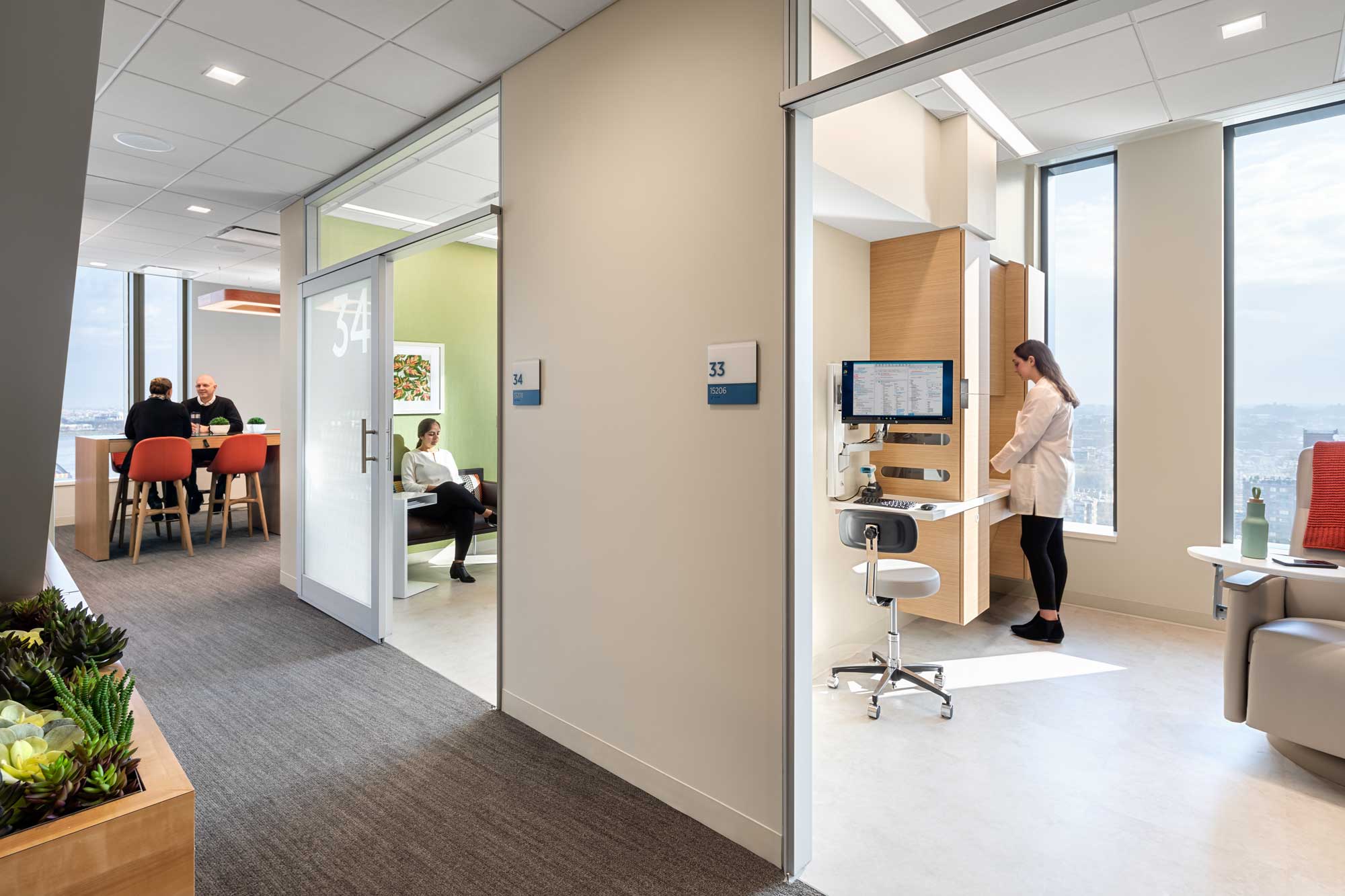
Selected Projects
The David H. Koch Center for Cancer Care at Memorial Sloan Kettering
Inova Oakville Potomac Yards Healthplex
Jefferson Health Specialty Care Pavilion
NYU Langone Health, Brooklyn Ambulatory Hub Building
Medical Education and Research
Our extensive experience with campus planning and facilities for higher education makes us uniquely positioned to design academic medical centers. Creating integrated, dynamic learning and teaching environments that serve large, diverse workplace populations and break down disciplinary silos is at the core of our practice. Thoughtful design of these facilities establishes new opportunities innovation and collaboration.
We create built environments that support research and teaching goals. Integrating new technology and digital tools, including simulation labs for patient interaction and actual procedures, foster new training, workforce pipeline development and lifelong learning. Our research facilities support enrollment of clinical trials and translational research and well as computational, data-driven research. We utilize architecture to improve the quality of the working environment, and creating vibrant research communities where investigation, invention and impact can thrive.
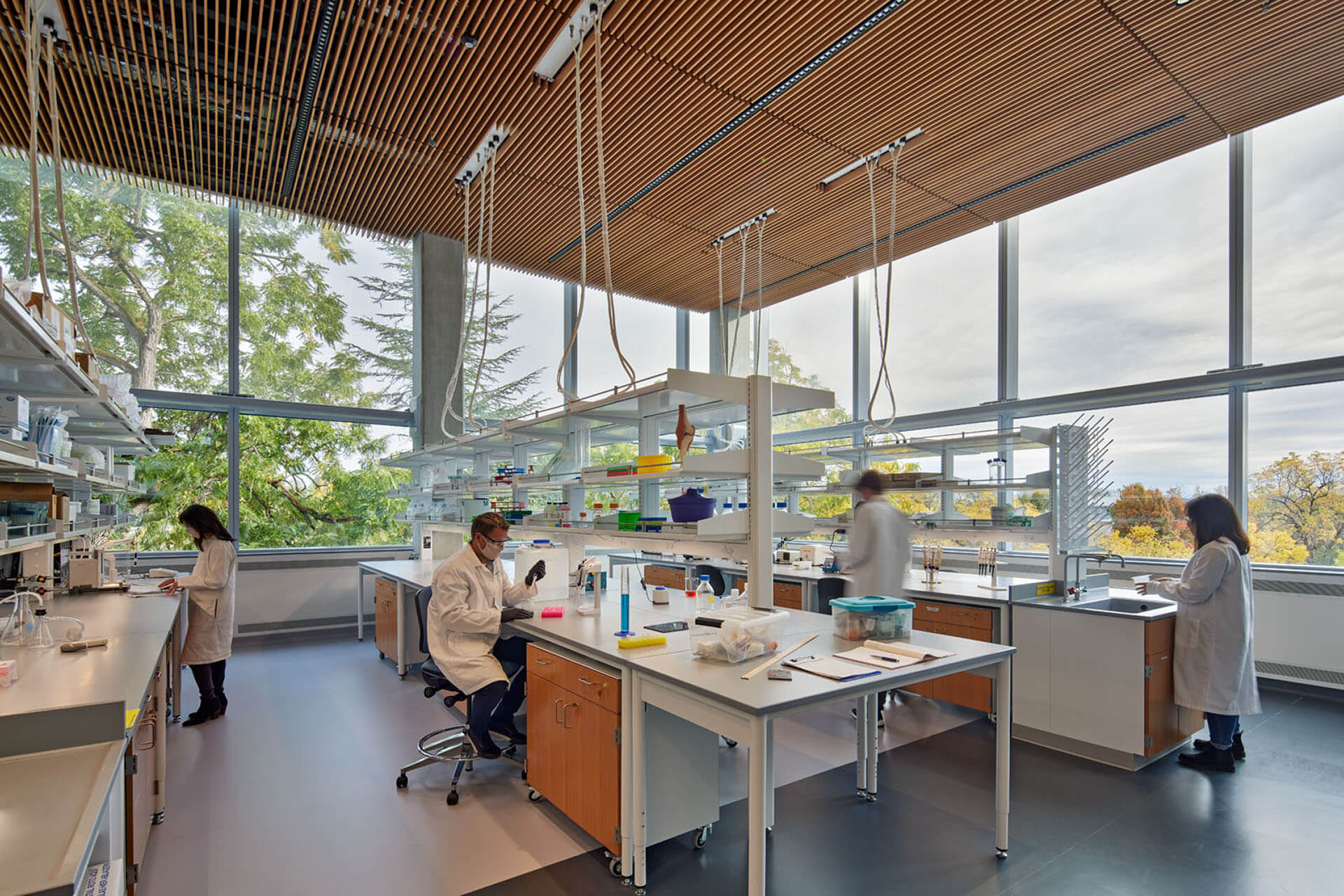
Selected Projects
City University of New York, Hunter College Science and Health Professions Building
NYU Langone Health, Science Building and School of Medicine
New York University, Center for Genomics and Systems Biology
University of Michigan, A. Alfred Taubman Biomedical Science Research Building




